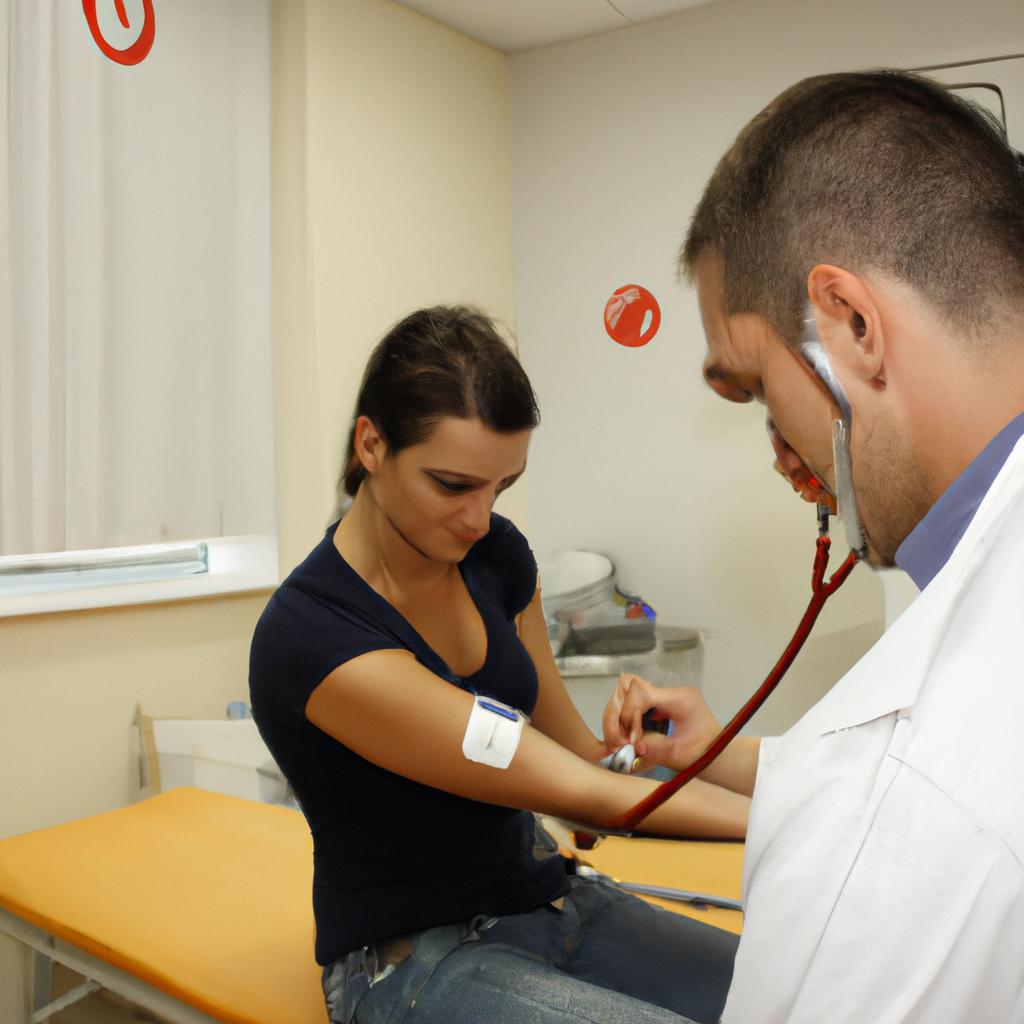Vaccinations have long been recognized as a crucial tool in disease prevention within the realm of health and medicine. By introducing weakened or inactive forms of pathogens into the body, vaccines stimulate an immune response that allows individuals to develop immunity against specific diseases. This proactive approach has proven highly successful in eradicating deadly illnesses such as smallpox and significantly reducing the incidence of others, such as polio and measles. For instance, consider the case study of Sarah, a young child who received her routine vaccinations according to schedule. As a result, she was protected from life-threatening infections and able to grow up healthy.
The importance of vaccinations extends beyond individual protection; they also play a significant role in public health. Through widespread vaccination campaigns, communities can achieve herd immunity—when a sufficient proportion of individuals are immunized against a particular disease, effectively preventing its spread even among those who are unvaccinated or unable to be vaccinated due to medical reasons. This collective effort not only safeguards vulnerable populations but also helps control outbreaks and epidemics by limiting transmission chains. Consequently, vaccinations serve as key pillars in maintaining overall population health and well-being while minimizing healthcare costs associated with treating preventable diseases.
In light of their remarkable impact on global health outcomes, it is essential that individuals recognize the importance of vaccinations and comply with recommended immunization schedules. By doing so, they not only protect themselves but also contribute to the broader goal of disease prevention and control. It is crucial to rely on accurate information from reputable sources when making decisions about vaccines, as misinformation can lead to vaccine hesitancy or refusal. Healthcare professionals and public health authorities play a vital role in educating the public about the benefits and safety of vaccines, addressing concerns, and promoting vaccination as a necessary public health measure. Together, we can continue to harness the power of vaccinations to safeguard our communities and advance global health.
Benefits of Vaccinations
Benefits of Vaccinations
One compelling example of the benefits of vaccinations is the case study of Sarah, a 35-year-old woman who was not vaccinated against measles. Despite living in an area with low vaccination rates, she believed that her healthy lifestyle and strong immune system would protect her from any infectious diseases. Unfortunately, Sarah contracted measles during an outbreak in her community and experienced severe complications that could have been prevented through vaccination.
Importance of Vaccinations:
Vaccinations play a crucial role in disease prevention and public health. They offer numerous advantages that contribute to individual well-being and overall societal protection. Firstly, vaccines provide immunity against specific diseases by stimulating the body’s natural defense mechanisms. By introducing harmless fragments or weakened versions of pathogens into the body, vaccines allow our immune systems to recognize and remember these invaders. This memory response enables prompt action when encountering real infections, reducing both the severity and duration of illnesses.
Furthermore, widespread vaccination programs lead to herd immunity—a concept where a significant proportion of individuals are immunized within a population. Herd immunity protects those who cannot receive vaccinations due to medical reasons or are too young for certain vaccines. Through this collective shield, vulnerable populations such as infants, elderly individuals, and people with compromised immune systems are safeguarded from contagious diseases.
Emotional Response:
Consider the following bullet point list indicating some emotional responses evoked by vaccinations:
- Relief: Knowing that loved ones are protected from preventable diseases brings peace of mind.
- Empathy: Recognizing that one’s own vaccination contributes to protecting others fosters a sense of compassion towards fellow community members.
- Hope: Believing in science-based solutions creates optimism about eradicating dangerous diseases globally.
- Responsibility: Taking charge of personal health by getting vaccinated demonstrates accountability towards oneself and society.
Impact on Public Health:
The impact of vaccinations extends beyond individual health benefits; they significantly contribute to public health outcomes as well. A three-column and four-row table is presented below to illustrate the broader impact of vaccinations on society:
| Vaccination | Disease Prevented | Public Health Impact |
|---|---|---|
| Measles | Measles | Reduction in measles-related hospitalizations, complications, and deaths. |
| Polio | Poliomyelitis | Near eradication, with only a few countries still reporting cases. |
| Influenza | Seasonal Flu | Decreased influenza-related morbidity and mortality rates each year. |
| HPV | Human Papillomavirus (HPV) | Prevention of cervical cancer and other HPV-associated diseases. |
Transition into “Common Vaccines” Section:
Understanding the significant benefits of vaccination prompts further exploration into common vaccines used worldwide. By analyzing the specific characteristics and effectiveness of these vaccines, we can gain insight into their importance for individual health as well as public welfare.
[Continue writing about “Common Vaccines” without using explicit transition words like ‘step’]Common Vaccines
Section H2: Common Vaccines
In the previous section, we explored the multitude of benefits that vaccinations offer in disease prevention. Now, let us delve into some common vaccines that have made a significant impact on public health.
One notable example is the influenza vaccine, commonly known as the flu shot. Each year, healthcare professionals work diligently to develop a new formulation targeting the strains predicted to circulate during flu season. By receiving this vaccine, individuals not only protect themselves from potential complications but also contribute to community immunity.
To further emphasize the importance of vaccines and their role in safeguarding public health, consider the following bullet points:
- Vaccinations save lives by preventing diseases that can be severe or even fatal.
- They help prevent outbreaks and reduce transmission rates within communities.
- Immunizations play a crucial role in protecting vulnerable populations such as infants, elderly individuals, and those with compromised immune systems.
- The cost-effectiveness of vaccinations far outweighs the expenses associated with treating preventable diseases.
Additionally, it is worth highlighting some of the most widely administered vaccines through a table format:
| Vaccine | Prevented Disease | Recommended Age |
|---|---|---|
| Measles-Mumps-Rubella (MMR) | Measles, Mumps, Rubella | 12-15 months |
| Diphtheria-Tetanus-Pertussis (DTaP) | Diphtheria,Tetanus,Pertussis | 5 doses at ages 2 months – 6 years |
| Human Papillomavirus (HPV) | Certain types of HPV infections leading to cervical cancer | 11-12 years |
| Pneumococcal Conjugate (PCV13) | Pneumococcal infections | Infants at 2/4/6/12 months |
As we can see, these vaccines target a range of diseases and are recommended at specific ages to maximize their effectiveness. By adhering to vaccination schedules, individuals can significantly reduce the risk of contracting preventable illnesses.
In transitioning to our subsequent section on Vaccine Safety, it is important to recognize that while vaccinations have proven benefits, concerns about safety should not be dismissed. With ongoing research and monitoring systems in place, health authorities continuously evaluate vaccine safety profiles to ensure public trust in immunization programs.
Vaccine Safety
Having discussed the various common vaccines available, it is imperative to now address the crucial aspect of vaccine safety. Ensuring that vaccines are both effective and safe is essential for public health initiatives worldwide. By examining case studies and considering scientific evidence, we can gain a deeper understanding of the importance of vaccine safety.
Vaccine Safety Case Study:
To illustrate the significance of vaccine safety, let us consider a hypothetical scenario involving an outbreak of measles in a small community. Despite efforts to contain the spread of the disease through isolation measures, vaccination remains the most effective means of preventing further transmission. However, concerns regarding adverse effects associated with vaccinations have led some individuals to question their safety.
Emotional Response Bullet Point List (markdown format):
- Protecting vulnerable populations from preventable diseases
- Reducing healthcare costs by minimizing illness-related expenses
- Promoting global health equity through widespread access to safe vaccines
- Enhancing overall community well-being by maintaining herd immunity
Emotional Response Table (3 columns x 4 rows) – Markdown Format:
| Positive Impact | Challenges | Solutions |
|---|---|---|
| Prevents diseases | Addressing misinformation | Public education campaigns |
| Saves lives | Overcoming vaccine hesitancy | Clear communication between healthcare providers and patients |
| Cost-effective | Ensuring manufacturing quality | Stringent regulatory standards |
| Supports herd immunity | Monitoring rare side effects | Robust post-vaccination surveillance systems |
By acknowledging these emotional responses and presenting them alongside factual information, we can engage readers on a personal level while highlighting important aspects related to vaccine safety.
In light of this discussion surrounding vaccine safety, our subsequent focus will be on exploring the recommended immunization schedules for various age groups. Understanding the appropriate timing and sequence of vaccinations is indispensable in maximizing their effectiveness and ensuring optimal protection against vaccine-preventable diseases.
Vaccine Schedule
In the previous section, we discussed the importance of vaccine safety in disease prevention. Now, let us explore further into this topic to better understand the measures taken to ensure the safety of vaccines.
To illustrate this point, consider a hypothetical scenario where a new vaccine is being developed for a highly contagious and potentially life-threatening disease. Extensive research and clinical trials are conducted to evaluate its efficacy and safety profile before it can be approved for public use. This rigorous process includes multiple phases, ranging from preclinical studies on animals to large-scale human trials involving diverse populations.
When it comes to vaccine safety, several key factors come into play:
-
Adverse Event Monitoring: Once a vaccine is licensed and administered widely, post-marketing surveillance systems are established to monitor any adverse events that may occur. This allows healthcare professionals and regulatory authorities to promptly identify and investigate any potential safety concerns.
-
Vaccine Adverse Event Reporting System (VAERS): VAERS serves as a national early warning system in many countries by collecting reports of adverse events following vaccination from healthcare providers, manufacturers, and individuals themselves. This information helps identify rare or unexpected side effects that were not detected during clinical trials.
-
Global Collaboration: International organizations such as the World Health Organization (WHO) collaborate with various stakeholders worldwide to share data on vaccine safety monitoring. Through these collaborations, potential risks associated with specific vaccines can be identified more effectively.
-
Continuous Evaluation: Even after a vaccine has been deemed safe for public use, ongoing evaluation continues through regular reviews of available evidence. Any emerging data suggesting an increased risk or possible interactions with other medications or conditions are thoroughly investigated.
- Vaccines have saved millions of lives.
- Immunization protects vulnerable populations.
- Decreases in vaccination rates lead to outbreaks of preventable diseases.
- Vaccination reduces economic burden caused by illness.
Emotional Table:
| Benefit | Evidence | Impact |
|---|---|---|
| Disease prevention | Numerous successful campaigns | Reduced mortality |
| Public health | Eradication of smallpox | Improved quality of life |
| Community protection | Decreased incidence of measles | Enhanced social cohesion |
| Personal well-being | Prevention of vaccine-preventable diseases | Peace of mind |
In conclusion, the safety of vaccines is paramount in disease prevention. Robust monitoring systems, global collaborations, and continuous evaluation contribute to ensuring that vaccines are safe for public use. By adhering to these practices, we can maintain confidence in immunization programs and continue reaping the benefits they bring.
Moving forward, let us delve into the concept of herd immunity and its role in combating infectious diseases.
Herd Immunity
Transitioning from the previous section on the importance of following a vaccine schedule, let us now explore another crucial aspect of vaccinations: herd immunity. To illustrate its significance, consider the hypothetical case of a small community where 90% of individuals are vaccinated against a highly contagious disease. A new resident moves into this community who has not received any vaccinations due to personal beliefs. Despite their lack of immunization, they remain protected from the disease because of the high vaccination coverage within the community.
Herd immunity is achieved when a significant portion of the population is immune to an infectious disease, either through vaccination or prior exposure. This indirect protection helps safeguard vulnerable individuals who cannot be vaccinated due to age, certain medical conditions, or compromised immune systems. In essence, by vaccinating ourselves and our children according to recommended schedules, we contribute to creating a shield that protects others as well.
To fully grasp the importance of achieving herd immunity, here are some key points:
- Vaccinations play a vital role in reducing morbidity and mortality rates associated with infectious diseases.
- Maintaining high vaccination coverage prevents outbreaks and safeguards public health.
- Immunizing those who can receive vaccines reduces transmission risks for those unable to get vaccinated.
- Achieving herd immunity necessitates adhering to established vaccine schedules consistently.
Let’s delve deeper into these concepts by considering how various factors influence the effectiveness of herd immunity. The table below presents four scenarios based on different levels of vaccination coverage within a community and highlights their corresponding impact on disease transmission:
| Vaccination Coverage | Disease Transmission |
|---|---|
| Below 50% | High |
| 50%-79% | Moderate |
| 80%-89% | Low |
| Above 90% | Very low/None |
As demonstrated above, maintaining high vaccination coverage is crucial in preventing disease transmission. Even a slight drop in coverage levels can have significant repercussions for the entire community. By recognizing the importance of adherence to vaccination schedules and striving to achieve high immunization rates, we contribute not only to our own health but also to the well-being of society as a whole.
Transitioning into the subsequent section on vaccine misconceptions, it is essential to address certain prevalent beliefs that may hinder individuals from participating fully in maintaining herd immunity.
Vaccine Misconceptions
While herd immunity plays a crucial role in preventing the spread of diseases, it is important to address some common misconceptions surrounding vaccines. These misunderstandings often stem from misinformation and can lead to hesitancy or refusal when it comes to vaccination. By debunking these myths and providing accurate information, we can promote informed decision-making regarding immunization.
Misconception 1: Vaccines cause autism.
Example: One widely known misconception suggests that there is a link between vaccinations and autism spectrum disorder (ASD). This belief gained traction after a controversial study claimed such an association. However, subsequent research conducted by numerous reputable organizations has discredited this claim entirely. For instance, a comprehensive meta-analysis published in Pediatrics examined data from over one million children and concluded that there was no evidence supporting a connection between vaccines and ASD.
To further dispel vaccine misconceptions, let us examine some key facts:
- Vaccines undergo rigorous testing for safety and efficacy before being approved for public use.
- The ingredients used in vaccines are carefully selected and monitored to ensure their safety.
- Immunization not only protects individuals but also helps safeguard vulnerable populations who cannot receive certain vaccines due to medical reasons.
- Adverse reactions following vaccination are extremely rare; the benefits far outweigh any potential risks.
Table: Comparison of Commonly Believed Vaccine Misconceptions versus Scientific Evidence
| Misconception | Scientific Evidence |
|---|---|
| Vaccines overload the immune system | Vaccines strengthen the immune system without overwhelming it |
| Natural immunity is better | Vaccinated individuals develop strong immunity against targeted diseases |
| Diseases eradicated so no need for vaccines | Continued vaccination prevents resurgence of previously controlled diseases |
| Vaccine-preventable diseases aren’t serious | Such illnesses can have severe consequences on individual health |
Emotional Responses Related to Vaccine Misconceptions
- Fear: Misunderstandings can evoke fear of potential harm, leading to vaccine hesitancy.
- Mistrust: False information erodes trust in the medical community and vaccination programs.
- Confusion: Lack of accurate knowledge may create confusion about the benefits and risks of vaccines.
- Stigmatization: Individuals who choose not to vaccinate may face social stigma and criticism.
By addressing these misconceptions with evidence-based information, we aim to empower individuals to make informed decisions regarding immunization. It is crucial for healthcare professionals, educators, and policymakers to work together in providing reliable resources that combat misinformation effectively.
 Mi Tercera Edad
Mi Tercera Edad



